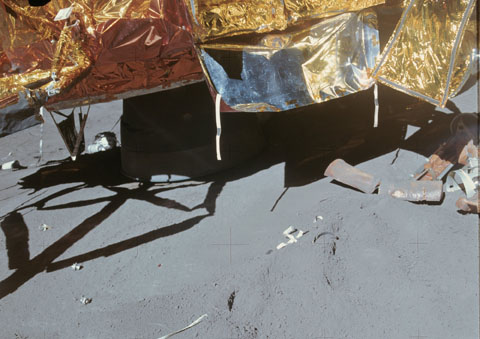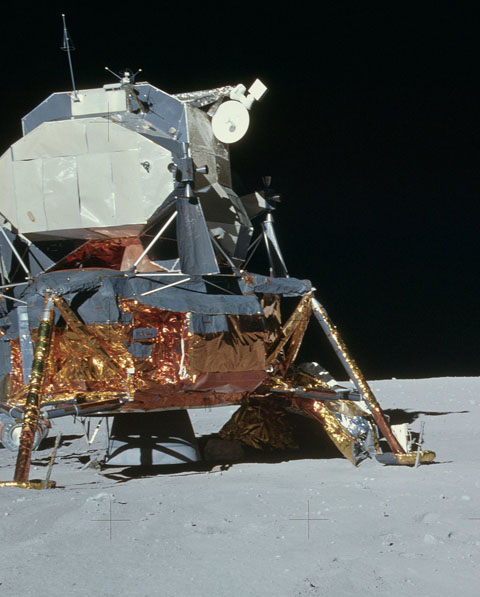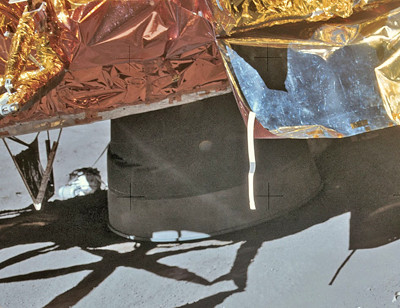|
Author
|
Topic: Height above surface at engine shutdown
|
Obviousman
Member Posts: 438
From: NSW, Australia
Registered: May 2005
|
 posted 10-26-2010 02:16 AM
posted 10-26-2010 02:16 AM
   
I seem to remember someone posted a table comparing the various heights above the lunar surface the various crews were when they shut down the DPS... but can't find it.Anyone know where I might find it? Apollo By The Numbers doesn't have what I am after. |
moorouge
Member Posts: 2484
From: U.K.
Registered: Jul 2009
|
 posted 10-26-2010 03:16 AM
posted 10-26-2010 03:16 AM
   
I can't help you with the other Apollo missions, but I recorded in my booklet "Manned Spaceflight" at the time that Apollo 17 made a perfect landing 3 feet above the surface. A perfect landing resulted - about three feet above the surface, for upon engine shut down only the contact probes were touching the Moon and the LM dropped the last part. Incidentally, Apollo 17 was the only flight that began PDI whilst the LM was still descending. Perilune had been established to the west of the landing site, all the other missions had perilune established to the east. |
Kite
Member Posts: 961
From: Northampton UK
Registered: Nov 2009
|
 posted 10-26-2010 02:40 PM
posted 10-26-2010 02:40 PM
  
On all accounts it seems that Apollo 11 made the softest landing with Neil Armstrong leaving it very late cutting the engine. A detailed description on page 472 of 'First Man', his biography by James R Hansen. Armstrong himself suggests he probably should have landed harder.This description of Apollo 17's landing according to Gene Cernan's autobiography 'The Last Man On The Moon' on page 319. "We dropped the last few feet with a stomach-flipping thud, jolted once and came to rest slightly tilted in a shallow depression." In Andrew Chaikin's 'A Man On The Moon', on page 643 of author's notes Harrison Schmitt warned Cernan that his descent rate down to the last 25 feet was a "a little high" with some intensity in his voice to hint at his concern. He was later to say that, with a laugh, "Gene had an aggressive streak in his flying". Obviously he got it right for the last three feet. The main thing is that all six landed ok but this is an interesting topic. |
SpaceAholic
Member Posts: 4897
From: Sierra Vista, Arizona
Registered: Nov 1999
|
 posted 10-26-2010 03:27 PM
posted 10-26-2010 03:27 PM
   
Review the Landing Dynamics section from each of the respective Apollo Mission reports for strut stroking distance, (any) pad slide-out, slope, footpad depth and rockup angle to cross compare the landings. Working through the calc's, you will also need to compensate for the larger mass of the J mission LMs. |
Spacepsycho
Member Posts: 872
From: Huntington Beach, Calif.
Registered: Aug 2004
|
 posted 10-26-2010 03:33 PM
posted 10-26-2010 03:33 PM
   
The softest lunar landing was accomplished by Apollo 14. There was so much dust that Shepard and Mitchell didn't know they were on the surface, until Mitchell looked at the control panel and saw the blue "contact light" was on. I'm guessing because of the dust, he was looking outside to help Shepard spot the ground and once Mitchell saw the "contact light" on, he hit the engine shutdown button. If I remember correctly, the film clearly shows the descent engine running for a few seconds, while the LM is on the surface. The landing gear probes that have the "contact light" sensors at the tips, extend 6' below the footpads, which is the height the engineers who built the descent engine, thought would be a safe distance to shutdown. It was feared that if the engine was running while on the surface, there wouldn't be enough room for the exhaust to escape and could possibly result in an explosive blowback into the LM descent engine. Conversely, the hardest landing was Apollo 16, where Duke shutdown the engine exactly at 6' and both astronauts thought the LM was going to tip over. If you look at the photos of Orion when photographed by Mattingly upon reaching lunar orbit, you can see some extensive damage to the exterior panels of the LM ascent module. Stark evidence of the impact that robust little spacecraft absorbed with no problems. |
SpaceAholic
Member Posts: 4897
From: Sierra Vista, Arizona
Registered: Nov 1999
|
 posted 10-26-2010 05:00 PM
posted 10-26-2010 05:00 PM
   
quote:
Originally posted by Spacepsycho:
Conversely, the hardest landing was Apollo 16, where Duke shutdown the engine exactly at 6' and both astronauts thought the LM was going to tip over.
Judging from this photographic evidence of Endeavor landing / nozzle deformation, Apollo 15's touch down was a bit more violent then 16. Compare with Apollo 16 / Orion:  |
micropooz
Member Posts: 1589
From: Washington, DC, USA
Registered: Apr 2003
|
 posted 10-26-2010 07:26 PM
posted 10-26-2010 07:26 PM
   
Wow, neither one looks pretty!!! I never realized that there was so much impact damage on those landings. Thanks gang! |
ilbasso
Member Posts: 1527
From: Greensboro, NC USA
Registered: Feb 2006
|
 posted 10-26-2010 07:52 PM
posted 10-26-2010 07:52 PM
   
At the Apollo 15 landing, Jim Irwin exclaimed, "Bam!" and later said, "No denying that, we had contact!"These notes are from the Landing section of the Apollo 15 Lunar Surface Journal: Irwin - "We did hit harder than any of the other flights! And I was startled, obviously, when I said, 'Bam!' (Laughing) And I think Dave didn't particularly appreciate my comment, that he made a hard landing on the Moon!" I have been able to find estimates of the vertical speed at touchdown on five of the six landings. Neil Armstrong's was the lowest at 1.7 feet/second because he didn't get the engine shutdown until after the footpads were on the surface. On Apollo 12, 14, and 17, the landing speeds were all between 3.0 and 3.5 feet/second. Dave's was by far the highest at 6.8 fps, most likely because he was the fastest to hit the engine stop button and, therefore, fell the farthest. Also, from the 1971 Debrief: Scott - "There was a rumble when we landed. I think all the equipment on board rattled. It seemed as if I could hear it all (despite the helmet he was wearing) when we landed, like you would shake the vehicle. Couldn't you hear that?"Irwin, - "Yes, I agree." |
SpaceAholic
Member Posts: 4897
From: Sierra Vista, Arizona
Registered: Nov 1999
|
 posted 10-26-2010 07:54 PM
posted 10-26-2010 07:54 PM
   
quote:
Originally posted by micropooz:
I never realized that there was so much impact damage on those landings.
The only apparent damage in those photos directly associated with touchdown (other then LSSP and strut compression) is the partial collapse of the LMDE nozzle on Endeavor; the balance of the debris is the byproduct of ALSEP and LRV deployment as well as refuge accumulated in conjunction with EVA. |
ejectr
Member Posts: 1849
From: Killingly, CT
Registered: Mar 2002
|
 posted 10-27-2010 05:54 AM
posted 10-27-2010 05:54 AM
   
Exactly. I don't see anything wrong with Orion. |
mark plas
Member Posts: 385
From: the Netherlands
Registered: Aug 2000
|
 posted 10-27-2010 07:36 AM
posted 10-27-2010 07:36 AM
   
Didn t Orion lost some panels during lunar liftoff? |
jasonelam
Member Posts: 693
From: Monticello, KY USA
Registered: Mar 2007
|
 posted 10-27-2010 10:08 AM
posted 10-27-2010 10:08 AM
   
There were no panels loose on Orion. The "damage" is loose mylar insulation that came loose on liftoff from the lunar surface. |
Spacepsycho
Member Posts: 872
From: Huntington Beach, Calif.
Registered: Aug 2004
|
 posted 10-27-2010 01:43 PM
posted 10-27-2010 01:43 PM
   
The photo of the Orion ascent module taken by Mattingly before docking, shows the damage to the back of the LM is worse than any other. All of the rivets holding the panels have been ripped open, so while the damage wasn't critical, it shows the deformation caused by the hard landing and subsequent lauch. You can see the photo here.As far as the damage comparing 15 and 16 is not evidenced in the photos. Other than the AP15 engine bell hitting the surface, which was expected during the design phase, with the collapsing landing gear absorbing most of the energy (in theory). The kapton panels were held on by velcro, so their displacement isn't anything vital and isn't proof of one landing harder than another. |
garymilgrom
Member Posts: 2053
From: Atlanta, GA
Registered: Feb 2007
|
 posted 10-27-2010 02:19 PM
posted 10-27-2010 02:19 PM
   
I have re-lit the Apollo 15 photo to show the damage to the engine bell caused by hitting the ground. As you can see it is very minor. |
SpaceAholic
Member Posts: 4897
From: Sierra Vista, Arizona
Registered: Nov 1999
|
 posted 10-27-2010 02:59 PM
posted 10-27-2010 02:59 PM
   
quote:
Originally posted by Spacepsycho:
The photo of the Orion ascent module taken by Mattingly before docking, shows the damage to the back of the LM is worse than any other.
Not the result of landing... quote:
As far as the damage comparing 15 and 16 is not evidenced in the photos. Other than the AP15 engine bell hitting the surface, which was expected during the design phase, with the collapsing landing gear absorbing most of the energy (in theory).
Endeavor's partially collapsed bell is an excellent comparative benchmark of relative deceleration forces encountered by both LM's. This is because the compression cartridges in the leg struts were by design non-elastic having been permanently crushed during the down-stroke. Orion exhibited virtually no stroking during touch-down - evidenced by the her Descent Engine's nozzle approximate half-foot clearance off the surface. |
Blackarrow
Member Posts: 3348
From: Belfast, United Kingdom
Registered: Feb 2002
|
 posted 10-27-2010 06:14 PM
posted 10-27-2010 06:14 PM
  
Point 1: some of you have forgotten that the Apollo 15 LM was named "Falcon." "Endeavour" was the CSM (note the British spelling in honour of Captain Cook!)Point 2: I recommend "Digital Apollo" by David Mindell which discusses and compares all of the six landings. One of the points made by Mindell concerning the Apollo 15 landing was the enlarged descent engine-bell. Dave Scott was warned of the risk of "blow-back" if, for instance, the enlarged bell came down over a small boulder. This could have caused an explosion. As instructed, he cut the engine as soon as the contact light came on. He was descending at one foot per second when he cut the engine, but the longer fall increased the contact speed. As it turned out, it was just as well he followed orders. Mindell points out that the enlarged engine bell came into contact with the edge of a small crater, buckling it. (What if the engine had still been firing when the engine-bell connected with the ground?) I am in the happy position of having discussed the Apollo 15 landing with both Dave Scott (2008) and Jim Irwin (1983). I wanted to try to establish why the landing felt much more jarring than the other landings. [See "Footprints in the Dust", pp. 242-245]. The actual landing speed doesn't account for the jarring, since the landing legs should have absorbed the impact. When I discussed this with Dave Scott, we concluded, based on the photographs of the "terrain" and the buckled engine-bell, that "Falcon" made a five-point landing (i.e. the landing legs and the rim of the engine-bell) rather than the usual four-point landing. The landing forces would have been transmitted up through the structure of the spacecraft, thus reducing the shock-absorbing properties of the crushable landing-legs. Hence the jarring. Each landing involved the risk of small craters and rocks being obscured from view by the flying dust. Al Shepard and Dave Scott ended up with legs in small craters, causing their LMs to tilt. If John Young had landed about ten feet back from his landing-point, he would have been into a deceptively steep crater and might have crumpled his engine bell on the rim. It wasn't as easy as they all made it sound! By the way, Garymilgrom's enhanced photo only shows a small part of the engine-bell buckling on "Falcon." NASA image AS15-88-11882 shows the full amount of the buckling. Gary - can you brighten that image for us? |
Obviousman
Member Posts: 438
From: NSW, Australia
Registered: May 2005
|
 posted 10-27-2010 06:20 PM
posted 10-27-2010 06:20 PM
   
Thanks to everyone - a fascinating read! |
gleopold
Member Posts: 32
From: Reston, VA, USA
Registered: Jun 2010
|
 posted 10-27-2010 07:00 PM
posted 10-27-2010 07:00 PM
   
A quick search for NASA image AS15-88-11882 also yielded a relevant paper delivered at an IEEE Aerospace Conference earlier this year titled, "The challenge of safe lunar landing". Here's the link to a summary and a password protected download. |
ilbasso
Member Posts: 1527
From: Greensboro, NC USA
Registered: Feb 2006
|
 posted 10-27-2010 07:09 PM
posted 10-27-2010 07:09 PM
   
As for Orion's ascent stage damage, there was evidence of some damage after landing. The buckled panels and damaged plume deflectors were photographed during one EVA. At liftoff, you can clearly see the panels come loose at the bottom and the inner Mylar insulation flap around at the moment of ascent engine ignition, if you watch the video of the lunar liftoff taken from the Rover. It looks to me like it's the blast from the ascent engine reflected off the descent stage upper deck that causes the panels and Mylar to come loose. |
compass
Member Posts: 42
From: uk
Registered: May 2007
|
 posted 10-29-2010 03:41 PM
posted 10-29-2010 03:41 PM
  
In Armstrong's book 'First Man' he indicates that he was confident the LM could have dropped the last 40-50 feet and landed, if Eagle ran out of fuel. I guess the honey comb compression capability of the landing struts permitted this. Also, when Orion landed on 16 Duke joked to Young that the landing was so hard it knocked his fillings loose. |














